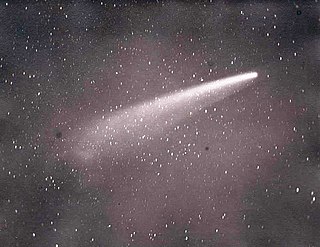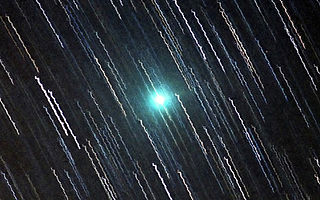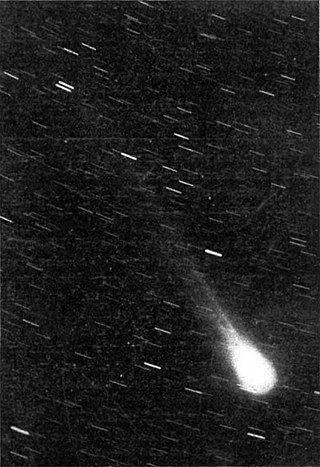
Comet Encke, or Encke's Comet, is a periodic comet that completes an orbit of the Sun once every 3.3 years. Encke was first recorded by Pierre Méchain on 17 January 1786, but it was not recognized as a periodic comet until 1819 when its orbit was computed by Johann Franz Encke. Like Halley's Comet, it is unusual in its being named after the calculator of its orbit rather than its discoverer. Like most comets, it has a very low albedo, reflecting only 4.6% of the light its nucleus receives, although comets generate a large coma and tail that can make them much more visible during their perihelion. The diameter of the nucleus of Encke's Comet is 4.8 km.

12P/Pons–Brooks is a periodic comet with an orbital period of 71 years. Comets with an orbital period of 20–200 years are referred to as Halley-type comets. It is one of the brightest known periodic comets, reaching an absolute visual magnitude of about 5 in its approach to perihelion. Comet Pons-Brooks was conclusively discovered at Marseilles Observatory in July 1812 by Jean-Louis Pons, and on its next appearance in 1883 by William Robert Brooks. However it has been confirmed 12P/Pons–Brooks was observed before the 19th century.

The Great Comet of 1882, formally designated as C/1882 R1, 1882 II, and 1882b, was a comet which became very bright in September 1882. It was a member of the Kreutz Sungrazers, a family of comets which pass within 1 R☉ of the Sun's photosphere at perihelion.

8P/Tuttle is a periodic comet with a 13.6-year orbit. It fits the classical definition of a Jupiter-family comet with an orbital period of less than 20 years, but does not fit the modern definition of. Its last perihelion passage was 27 August 2021 when it had a solar elongation of 26 degrees at approximately apparent magnitude 9. Two weeks later, on September 12, 2021, it was about 1.8 AU (270 million km) from Earth which is about as far from Earth as the comet can get when the comet is near perihelion.

Comet IRAS–Araki–Alcock is a long-period comet that, in 1983, made the closest known approach to Earth of any comet in the last 200 years, at a distance of about 0.0312 AU.
169/NEAT is a periodic comet in the Solar System. It is the parent body of the alpha Capricornids meteor shower in Late July. 169/NEAT may be related to comet P/2003 T12 (SOHO). 169P is a low activity comet roughly a few kilometers in diameter. It could have originated from the main asteroid belt.

13P/Olbers is a periodic comet with an orbital period of 69 years. It fits the classical definition of a Halley-type comet with a period between 20 and 200 years. The comet last passed perihelion 30 June 2024 and it was previously seen in 1956. The next perihelion is in 2094.
Comet C/1861 G1 (Thatcher) is a long-period comet with roughly a 422-year orbit that is expected to return around 2283. It was discovered by A. E. Thatcher. It is responsible for the April Lyrid meteor shower. Carl Wilhelm Baeker also independently found this comet. The comet passed about 0.335 AU from the Earth on 5 May 1861 and last came to perihelion on 3 June 1861.
C/2007 W1 (Boattini) is a non-periodic comet discovered on 20 November 2007, by Andrea Boattini at the Mt. Lemmon Survey. At the peak the comet had an apparent magnitude around 5.

Comet van Gent–Peltier–Daimaca, formally designated as C/1943 W1, is a non-periodic comet with a rather peculiar discovery. It was independently discovered by four astronomers, however the established system of naming comets by the International Astronomical Union only recognizes the names of the first three people who observed it.

C/2016 U1 (NEOWISE) is a hyperbolic comet discovered 21 October 2016 by NEOWISE, the asteroid-and-comet-hunting portion of the Wide-Field Infrared Survey Explorer (WISE) mission. The comet brightened to magnitude +6.8 and could be observed with binoculars, during the first week of 2017 and it was closest to the Sun on 14 January 2017.

C/1963 A1 (Ikeya), also known as Comet 1963I and 1963a, is a long period comet discovered by Kaoru Ikeya on 2 January 1963. The comet last passed perihelion on 21 March 1963, when it reached an apparent magnitude of 2.8.

C/1979 Y1 (Bradfield), also known as Comet 1979X and 1979l, is a long period comet discovered by William A. Bradfield on 24 December 1979. The comet has an orbital period of 308 ± 6 years and last passed perihelion on 21 December 1979. It is considered to be the parent body of the July Pegasids meteor shower. It is expected to next come to perihelion around 2287.
C/1917 F1 (Mellish), also known as Comet 1917Ι and 1917a, is a Halley-type comet discovered by John E. Mellish on 19 March 1917. The comet has an orbital period of 143 years and last passed perihelion on 11 April 1917. It is the parent body of the December Monocerotids and has also been suggested to be the parent body of daytime kappa Leonids, April ρ-Cygnids, November Orionids, and Canis-Minorids meteor showers.

Comet Mellish, also known formally as C/1915 C1, is one of five comets discovered by American astronomer John E. Mellish. It is a hyperbolic comet that reached perihelion on July 17, 1915. However, just two months earlier, Edward E. Barnard had reported the comet had splitted into three distinct objects in May 12, later increasing to four by May 24. In addition, it is thought that this comet was the parent body of the June Lyrids meteor shower, which was first discovered in 1966.
Comet Donati, formally designated as C/1864 R1, is a parabolic comet discovered in 1864. It was the last of five comets discovered by Italian astronomer, Giovanni Battista Donati. This comet might be the potential parent body of the Gamma Normids meteor shower.

C/1911 N1 (Kiess) is a non-periodic comet discovered by Carl Clarence Kiess on 6 July 1911. The comet has been identified as the parent body of the Aurigids meteor shower.

C/1907 G1 (Grigg–Mellish) is a long-period comet discovered independently by John Grigg and John E. Mellish in April 1907. The comet has been identified as the parent body of the delta Pavonids meteor shower.
Comet Petersen, also known as C/1848 P1 by modern nomenclature, is a parabolic comet that was seen during the month of August 1848. It is first of three comets discovered by German astronomer, Adolph C. Petersen.

Comet Rordame–Quénisset, also known as C/1893 N1 by its modern nomenclature, is a hyperbolic comet that was visible in the naked eye in 1893. It was discovered independently by Alfred Rordame and Ferdinand Quénisset, though several astronomers reportedly saw the comet days before their respective discoveries.
















